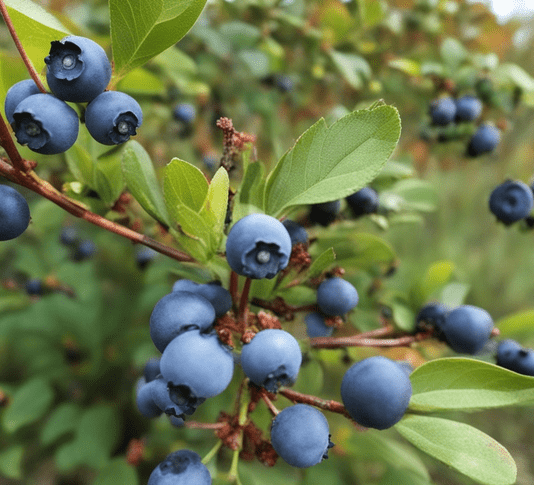Ever dreamed of cultivating the juiciest organic blueberries right in your backyard? Have you wondered about the secrets to growing these antioxidant-packed delights? Uncover the art of planting organic blueberries with our comprehensive guide. From selecting the perfect location to nurturing, pruning, and harvesting, this guide is your key to a flourishing organic blueberry haven. Dive in, and discover not just the joy of gardening but the promise of sweet, organic blueberry rewards that await you.
Choosing the Right Location for Planting Organic Blueberries
Embark on your organic blueberry journey by understanding the crucial elements of choosing the perfect location.
- Sunlight Exposure: Ensure your chosen spot receives ample sunlight, a minimum of six hours per day, for robust growth and flavorful harvests.
- Air Circulation: Optimize air circulation to prevent diseases. Adequate airflow fosters a healthier environment for your organic blueberries.
- Soil Drainage: Organic blueberries prefer well-draining soil. Evaluate your soil’s drainage capacity to prevent waterlogged conditions that can harm the roots.
- Elevation and Frost Protection: Consider the elevation and implement measures for frost protection in colder regions. Safeguard your organic blueberries from late spring frosts.
- Structural Support: Assess the need for structural support, especially in windy areas. Proper support ensures your organic blueberry bushes can withstand environmental challenges.
- Microclimates: Explore microclimates within your garden to create optimal growing conditions for different varieties of organic blueberries.
Preparing the Soil for Planting Organic Blueberries
Set the foundation for a thriving organic blueberry patch by preparing the soil with care.
- Early Preparation: Initiate soil preparation well in advance. Clear the area of debris, weeds, and rocks to create a clean canvas for your organic blueberry bushes.
- Incorporating Organic Matter: Enrich the soil by incorporating organic matter such as compost or well-rotted manure. This enhances soil fertility and provides essential nutrients for robust plant growth.
- Soil Test: Conduct a soil test to understand its composition and nutrient levels. Adjust the pH and nutrient balance based on the specific requirements of organic blueberries.
- pH Adjustment: Organic blueberries thrive in acidic soil with a pH between 4.0 and 5.0. Adjust the pH using amendments like sulfur or pine needles to create an optimal growing environment.
- Enhancing Drainage: Improve soil drainage by incorporating sand or perlite. Well-draining soil prevents waterlogging, fostering a healthy root system.
- Weed Control: Implement effective weed control measures. Mulching and regular weeding help suppress weed growth, reducing competition for nutrients and moisture.
Selecting and Purchasing Organic Blueberries Plants
Unlock the secrets to selecting the perfect organic blueberry plants. Follow three or four essential steps to ensure you bring home the right varieties for your specific growing conditions.
- Assess Your Growing Conditions: Before you start shopping for organic blueberry plants, assess your growing conditions. Consider factors such as climate, soil type, and available sunlight.
- Research Blueberry Varieties: Conduct thorough research on various cultivars, considering factors such as fruit size, flavor profile, and disease resistance.
- Purchase from Reputable Nurseries: Choose a reputable nursery or garden center for your blueberry plant purchases. Look for establishments with a history of providing healthy and disease-free plants.
- Check Plant Health and Vigor: Examine the health and vigor of the blueberry plants before making a purchase. Inspect the foliage for signs of pests, diseases, or nutrient deficiencies.
Planting Organic Blueberries – Step-by-Step Guide
Embark on the exciting journey of planting organic blueberries with a step-by-step guide to ensure success.
- Selecting Quality Plants: Choose healthy and disease-free organic blueberry plants. Inspect the foliage for pests, diseases, or abnormalities. Opt for plants with vibrant green leaves and sturdy stems, indicating good overall health.
- Timing is Everything: Plant your organic blueberries in the early spring or late fall when the plants are dormant. This allows them to establish their root systems before the growing season.
- Digging the Perfect Hole: Dig holes that are twice as wide as the root ball and just as deep. This provides ample space for the roots to spread out and establish a strong foundation.
- Planting Depth Matters: Ensure that you plant the organic blueberries at the same depth they were in the nursery container. Planting too deep or too shallow can affect the plant’s health.
- Mulch for Moisture Retention: Apply a layer of organic mulch around the base of each plant. Mulch helps retain moisture, suppress weeds, and regulate soil temperature, creating optimal conditions for organic blueberries.
- Watering: Water the newly planted blueberries thoroughly. Keep the soil consistently moist, especially during dry spells. Adequate hydration is crucial for the establishment of young plants.
- Support Structures: Provide support structures, if necessary, to protect the plants from strong winds or heavy fruit loads. Staking or caging may be required for taller varieties.
- Monitor and Adjust: Regularly monitor the soil moisture, especially during the first growing season. Adjust watering practices based on weather conditions and the specific needs of your organic blueberries.
- Prune for Growth: While minimal pruning is required at planting, remove any damaged or dead branches. This encourages healthy growth and shape development.
Caring for Organic Blueberries
Ensure the ongoing health and productivity of your organic blueberries with these essential care practices.
- Watering: Maintain consistent soil moisture throughout the growing season. While organic blueberries are relatively drought-tolerant, adequate hydration supports optimal growth and fruit development.
- Fertilizing: Fertilize your organic blueberries in the early spring with organic, acidic fertilizers. Follow recommended application rates based on the age and size of the plants.
- Mulching: Renew the mulch around your blueberry plants each year. This helps retain soil moisture, suppress weeds, and provide a steady supply of organic matter.
- Pruning: Conduct annual pruning during the dormant season to shape the bushes, remove dead or weak wood, and encourage new growth. Pruning also enhances air circulation within the canopy.
- Training and Support: Continue providing support structures, such as stakes or cages, as needed. Regularly inspect and adjust these structures to accommodate the growth of your organic blueberry bushes.
- Pest and Disease Monitoring: Keep a watchful eye for signs of pests and diseases. Early detection allows for prompt intervention and minimizes the impact on plant health.
- Harvesting Practices: Harvest your organic blueberries when they reach peak ripeness. Gently pluck the berries to avoid damaging the plant and ensure the best quality fruit.
- Winter Preparation: In late fall, prepare your organic blueberries for winter by adding a layer of mulch around the base of each plant. This helps insulate the roots and protect them from harsh winter conditions.
Pruning and Training Organic Blueberries
Learn Pruning from this guideline.
Address Crossing Branches:
Identify and address crossing branches that may rub against each other. Crossing branches can create points of entry for diseases and hinder the overall health of the bush.
Remove Weak or Unproductive Wood:
Identify and remove weak or unproductive wood. This redirects the plant’s energy toward healthier branches that are more likely to bear abundant fruit.
Adjust Support Structures:
If you’ve provided support structures for your blueberry bushes, adjust them as needed. Ensure that the support system adequately accommodates the size and structure of the bush.
Encourage Vertical Growth:
Encourage vertical growth by selectively pruning horizontal or drooping branches. This promotes a more upright growth habit, which can enhance air circulation and make harvesting more accessible.
Monitor for Diseases:
While pruning, keep an eye out for any signs of diseases or pests. Promptly remove affected branches to prevent the spread of issues throughout the plant.
Sterilize Pruning Tools:
Before and after pruning each plant, sterilize your pruning tools to minimize the risk of spreading diseases. A simple solution of bleach and water can be effective for this purpose.
Consider Plant Age:
Adjust your pruning approach based on the age of the plant. Young plants may require more shaping, while older plants benefit from maintenance pruning to renew and invigorate growth.
Remember, effective pruning and training contribute to the overall health and productivity of Organic Blueberries, ensuring a bountiful harvest year after year.
Common Pests and Diseases of Organic Blueberries
Safeguard your Organic Blueberries from potential threats by understanding and addressing common pests and diseases.
Blueberry Maggots: Identify blueberry maggots by monitoring for small puncture wounds on berries. Use insecticides or traps to manage infestations, and promptly remove and destroy affected fruit.
Aphids: Keep an eye out for aphids on the undersides of leaves. Hose off aphids with a strong stream of water, or introduce natural predators like ladybugs to control their population.
Mummy Berry Disease: Prevent mummy berry disease by applying organic fungicides at the right time, typically during bud break. Remove and destroy any fallen berries, as they can harbor the fungal spores.
Botrytis Blight: Manage botrytis blight by ensuring good air circulation, especially in humid conditions. Remove and dispose of any infected plant material, and consider applying organic fungicides preventatively.
Scale Insects: Control scale insects by pruning and disposing of infested branches. Introduce natural predators, such as parasitic wasps, and use horticultural oils to manage scale populations.
Leaf Spot Diseases: Address leaf spot diseases by applying organic fungicides and practicing good sanitation. Remove and destroy infected leaves, and avoid overhead watering to minimize moisture on foliage.
Spotted Wing Drosophila: Monitor for spotted wing drosophila by using traps and harvesting fruit promptly. Consider applying organic insecticides, and clean up fallen fruit to reduce the risk of infestation.
Japanese Beetles: Control Japanese beetles by handpicking or using organic insecticides. Consider planting beetle-resistant companion plants and removing beetles manually to minimize damage.
By staying vigilant and implementing organic preventive measures, you can protect your Organic Blueberries from these common pests and diseases, ensuring a healthy and productive crop.
How To Harvesting Organic Blueberries
Embark on the final and rewarding stage of your blueberry journey by mastering the art of harvesting Organic Blueberries.
Monitor Ripeness: Regularly monitor the ripeness of your blueberries. Look for berries that have turned fully blue, indicating maturity and sweetness.
Gentle Harvesting: Harvest blueberries gently to avoid damaging the delicate fruit. Hold the stem with one hand and use the other to pick the berries, leaving the stem attached.
Harvesting Frequency: Harvest frequently as the berries ripen. This ensures that you collect berries at their peak, promotes continuous production, and prevents overripening on the bush.
Use a Berry Comb: Consider using a berry comb for efficient harvesting. Gently comb through the clusters to dislodge ripe berries, allowing them to fall into a collection container.
Morning Harvest: Opt for morning harvests when temperatures are cooler. This minimizes stress on the berries and preserves their firmness.
Avoid Crushing Berries: Handle harvested berries with care to avoid crushing them. Use shallow containers to prevent the weight of the berries from squashing those at the bottom.
Post-Harvest Handling: Upon harvest, promptly refrigerate or process the berries. Refrigeration maintains freshness, while processing allows you to enjoy your organic harvest in various culinary delights.
Conclusion
Embarking on the journey of planting and nurturing organic blueberries offers not just a garden transformation but a delightful connection to nature’s bounty. This comprehensive guide equips you with the knowledge to create a thriving organic blue



